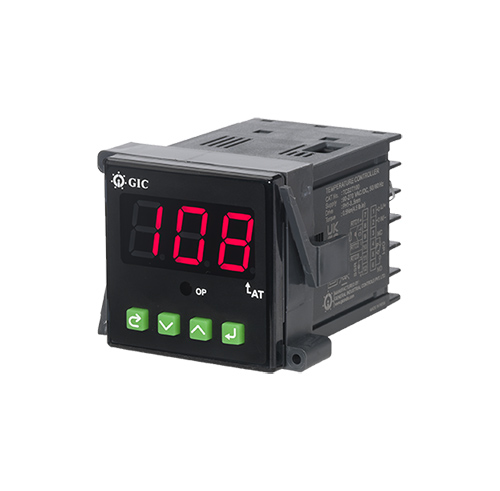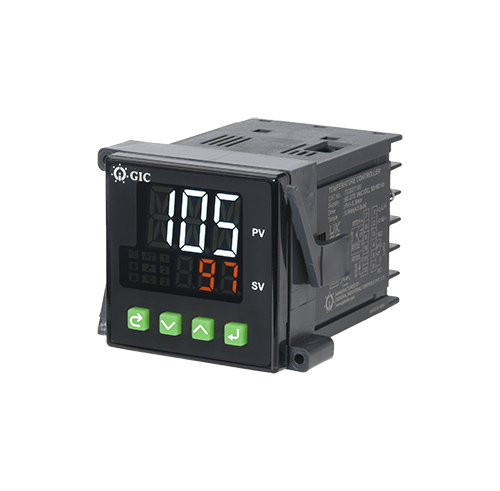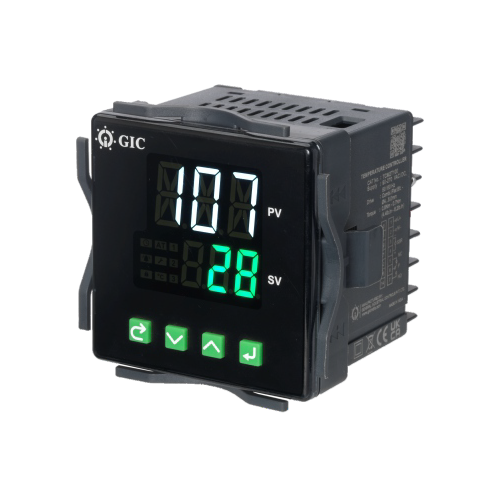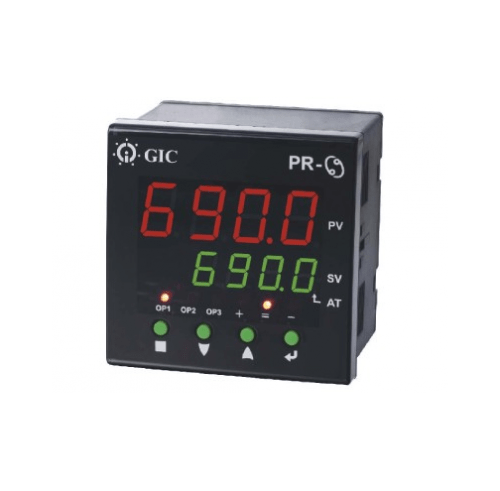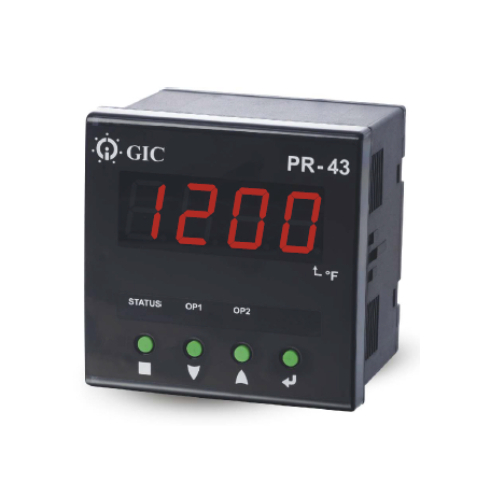As the name suggests, a Temperature controller is a device that controls the temperature of any system. With Sensors J, K and RTD input, the digital temperature controller shows the process’s current temperature. Whereas the temperature controller also accepts the input from the pressure transmitter in analogue signal input. Display scaling enables it to show the required readings according to the variation in input.
A temperature controller is a vital device used to regulate and maintain the desired temperature in various systems and processes. It serves as a crucial component in achieving precise temperature control, ensuring optimal performance, product quality, and safety. Whether it's in industrial settings or laboratories, temperature controllers play a fundamental role in maintaining temperature stability.
Supply Voltage +
Mode +
Mounting +
Relay +
No. Of Programs +
Display +
Power Reserve +
Clock Accuracy +
Pre-Programmed +
Accessories +
Product visibility +
Analog Input +
Base/Ext +
Bazel type +
Center Distance +
Clock +
Control Action +
Display with & without +
Input/Output +
No. of digits +
No. of set points +
Output +
Output 1 +
Output 2 +
Output 3 +
Product Type +
Read Out +
Register +
RS485 Communication +
Sensor Input +
Size +
Termination +
Contact +
Delay +
Enclosure Design +
Function +
Input Voltage +
Output Current +
Output Voltage +
Power +
Relay Output +
Supply +
Timing Range +
Variant +
Alarm Output +
Analog Output +
Auto Reset time +
Auxiliary Supply +
CBCT Size +
Colour +
Current Range +
Digital Display +
Digital Input +
Digital Output +
Display Colour +
High Speed Inputs +
Input Signal +
LCD Display +
Leakage Current +
Module +
Neutral Loss +
Output Signal +
Over Frequency +
Over Voltage +
Phase Asymmetry +
Phase Loss +
Phase Sequence +
Reset +
Sensor Supply +
Series +
Settable Off Delay +
Settable On Delay +
System +
Transistor Output +
Under Frequency +
Under Voltage +
Voltage +
Why are Temperature Controllers Important?
Temperature controllers play a crucial role in various industries and applications where precise temperature control is essential. They provide numerous benefits and contribute to improved efficiency, product quality, and safety. Let’s explore why temperature controllers are important and when they should be used.
Temperature controllers are vital for maintaining consistent and accurate temperature levels in industrial processes. They ensure that critical parameters are controlled within specified ranges, resulting in optimal product quality. For example, in the food industry, precise temperature control during cooking, baking, or refrigeration processes is crucial to achieving desired textures, flavours, and shelf life.
Digital temperature controllers offer advanced features, such as precise temperature readouts and programmable settings. They provide enhanced accuracy and control, allowing for more precise temperature adjustments in applications that require tight control, such as scientific laboratories and research facilities.
Types of Temperature Controllers
On/Off Controllers
On/Off controllers are the simplest type of temperature controller. They operate by switching the heating or cooling device ON when the temperature falls below a setpoint and OFF when it exceeds the setpoint. On/Off controllers are widely used in applications where precise temperature control within a narrow range is not critical. Examples include residential heating systems, cooling fans, and basic industrial processes.
Proportional Controller
Proportional controllers offer more advanced temperature control compared to On/Off controllers. They modulate the heating or cooling output based on the deviation between the actual temperature and the set point. Proportional controllers provide a proportional response, adjusting the output in proportion to the error. They are suitable for applications that require more precise temperature control. Examples include incubators, ovens, and HVAC systems in commercial buildings.
PID Controllers
PID (Proportional-Integral-Derivative) controllers are the most advanced type of temperature controller. They incorporate proportional, integral, and derivative control actions to achieve precise temperature regulation. PID controllers continuously adjust the output based on the error, past errors, and the rate of change of error. They provide fast response and stability, making them ideal for applications with strict temperature requirements, such as industrial processes, laboratory equipment, and advanced HVAC systems.
What is a Digital PID Controller?
A digital PID controller is an advanced electronic device that utilizes digital signal processing techniques to implement PID temperature controller control algorithms for precise and accurate temperature regulation. PID stands for Proportional-Integral-Derivative, which are the three control actions incorporated in the controller. Digital PID controllers also provide analogue output where it operates according to the change in input called retransmission.
Digital PID controllers offer several advantages over analogue PID controllers. They provide enhanced control accuracy, faster response times, and greater flexibility in parameter tuning. These controllers utilize digital computation to process temperature data and apply control actions, resulting in improved temperature regulation and stability.
Applications and Uses for Digital PID Controller
Digital PID controllers find extensive applications in various industries and processes where precise temperature control is crucial. They are commonly used in Industrial Automation, Research and Development, and Food Processing.
Industry Applications for Temperature Controller
Packaging Industry
In the packaging industry, it plays a vital role in ensuring the quality and integrity of packaged products. They are used in sealing machines, where precise temperature control is required to create a secure and airtight seal. GIC’s PID digital temperature controller helps maintain the optimal temperature for sealing, preventing leaks and preserving the freshness of packaged goods.
Metal Industry
It is extensively used in the metal industry for various heating and cooling processes. They are employed in heat treatment furnaces, where precise temperature control is crucial to achieve desired metal properties such as hardness, strength, and durability. GIC’s PID digital temperature controllers are also used in metal melting furnaces, where they regulate the temperature to ensure optimal melting and casting conditions for metal production.
Food Industry
GIC’s temperature controllers are used in food processing equipment, such as ovens, fryers, and refrigeration units, to maintain precise temperature levels during cooking, frying, cooling, and storage processes. They enable consistent and controlled heat transfer, ensuring that food is cooked thoroughly, stored at the correct temperatures, and remains safe for consumption.
Plastic Industry
GIC’s PID temperature controller finds wide application in the plastic industry, particularly in injection moulding machines. These machines require precise temperature control during the plastic melting and moulding process.
Heaters and Furnaces
GIC’s PID temperature controllers are essential in heaters and furnaces used in various industries such as chemical processing, oil and gas, and power generation. They regulate the temperature of these heating systems, ensuring safe and efficient operation.
Boilers
In the boiler industry, they play a critical role in maintaining precise water temperature and steam pressure. They are used to regulate the fuel input and combustion process in boilers, ensuring efficient heat generation.
Timer functionality allows the user to maintain a particular temperature for a defined period. The configurable alarm functions provide an alarm indication to have the operator’s attention on the fault condition. Ramp soak functionality makes it suitable to operate at three different temperature conditions. Various output configurations make it ideal for other applications. RS485 communication helps to communicate with external devices like PLC, HMI, PC etc.
Process value and set value can be seen at a time on the dual display of the Digital PID controller, which helps the operator to compare between two values. A bigger size display provides visibility from a long distance. Various LED indications on display Digital PID controller supports to indicate the current operating condition of the system. Configurable shortcut keys enable access to parameters easily.
CE certification and protections like IP20 and IP40 protection provide quality assurance for temperature controllers.
Features of PID Digital Temperature Controller
- 4 Digit Dual display
- Universal Input
- Configurable output combinations
- Sensor break, Loop break alarm
- Configurable band and deviation alarm
- 3 Ramp and Soak steps
- Retransmission
- Timer functionality with settable time
- 6 LED indications, Output, tune
- RS485 Communication
- Service / Load hours measurement
Frequently Asked Questions
Temperature controller is required in many industries – Packaging, Food, Chemical, Plastic, Healthcare etc.
- Type of Input – Sensor/Analog/Both
- Temperature Range
- Sensor Compatibility
- Control Algorithm
- Size and Mounting
- Type of Output – Relay/SSR/Both
- P (Proportional) Controller
- PI (Proportional-Integral) Controller
- PID (Proportional-Integral-Derivative) Controller
- On/Off Controller
On/Off controllers provide a binary control action, P controllers offer proportional control, PI controllers add integral control to reduce steady-state errors, and PID controllers incorporate proportional, integral, and derivative control actions for precise and stable control. The choice of controller depends on the application requirements, system dynamics, and desired control performance.

